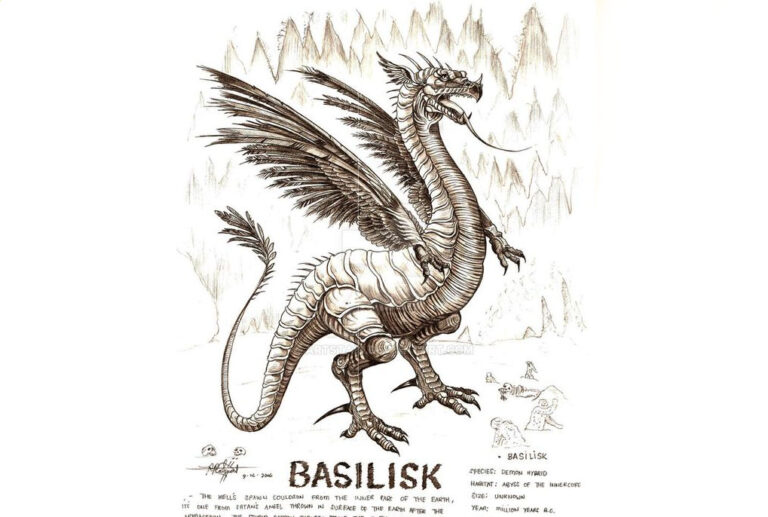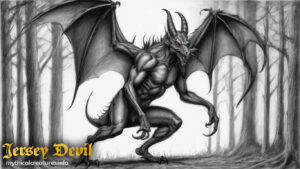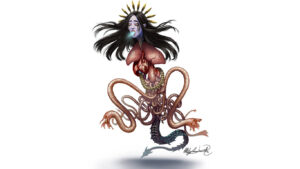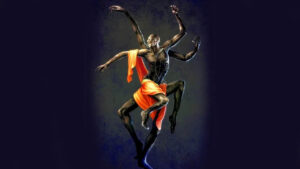Table of Contents
What is a Basilisk?
In mythology, a basilisk is often depicted as a legendary reptile, sometimes with a mix of serpent and rooster features. The basilisk is often said to be extremely venomous and capable of causing death with a single glance or breath. It is sometimes described as having the ability to petrify or turn people to stone with its gaze.
The concept of the basilisk has varied across different cultures and time periods. In European folklore, the basilisk is associated with medieval bestiaries and was often considered the king of serpents. It was believed that the basilisk could be born from a serpent’s egg incubated by a rooster. The creature’s deadly reputation and fearsome abilities have made it a popular subject in literature, including works by famous writers such as Geoffrey Chaucer and William Shakespeare.
Physical Description
The physical description of the basilisk can vary across different cultural and literary traditions, but some common characteristics include:
Serpentine Form: The basilisk is often depicted as a serpent or dragon-like creature. It may have a long, sinuous body with scales.
Crest or Crown: In some depictions, the basilisk is described as having a crown-like crest or a comb on its head, resembling the comb of a rooster. This is linked to the belief that the basilisk could be born from a serpent’s egg incubated by a rooster.
Combination of Features: As mentioned earlier, the basilisk is sometimes described as a hybrid creature with features of both a serpent and a rooster, combining the body of a snake with the head or crest of a rooster.
Venomous Gaze: One of the most famous characteristics of the basilisk is its deadly gaze. It is said that direct eye contact with the basilisk could cause death or turn the observer to stone. This aspect is often emphasized in mythological accounts.
Venomous Breath: In addition to the gaze, some traditions attribute a lethal breath to the basilisk. The creature may be described as exhaling toxic fumes or venom.
Dragon-Like Qualities: In certain cultures, the basilisk is associated with dragons and may share some dragon-like characteristics, such as wings or the ability to breathe fire.
Lethality: The basilisk is consistently portrayed as a highly dangerous and lethal creature. Its mere presence is believed to be a threat to human and animal life.
Special Abilities
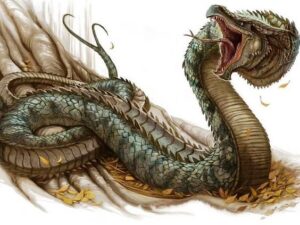
The basilisk is often attributed with several special abilities, contributing to its fearsome reputation in mythology. These abilities can vary across different cultural and literary traditions, but some common ones include:
Deadly Gaze: The basilisk’s gaze is perhaps its most infamous ability. It is said that making direct eye contact with the basilisk could result in death or petrification. This gaze is often considered a potent and immediate threat.
Venomous Bite or Breath: In addition to its gaze, the basilisk may possess a venomous bite or breath. The mere proximity of the creature could be dangerous, as it could release toxic fumes or venom capable of causing harm.
Stone Petrification: Some accounts describe the basilisk’s ability to turn living beings, particularly humans, into stone. This adds an element of horror to the creature’s legend, as it can strike fear into those who might encounter it.
Birth from a Serpent’s Egg: According to certain traditions, the basilisk is believed to be born from a serpent’s egg incubated by a rooster. This unusual origin story contributes to its hybrid nature and may be associated with its deadly qualities.
Rooster Characteristics: As a result of its supposed birth from a serpent’s egg incubated by a rooster, the basilisk may exhibit rooster-like qualities, such as a comb on its head or other features associated with roosters.
Flight: In some depictions, the basilisk is described as having wings, enabling it to fly. This dragon-like characteristic adds to its mythical and supernatural nature.
Immunity to its Own Venom: In some traditions, the basilisk is said to be immune to its own venom. This immunity contributes to its invulnerability and makes it an even more formidable opponent.
Weaknesses
Mirror Reflection: In some legends, it is said that the basilisk can be defeated or repelled by its own reflection in a mirror. The idea is that the creature, upon seeing itself, would be affected by its own gaze or abilities.
Cock’s Crow: Given the association of the basilisk’s birth with a rooster, it is sometimes believed that the crowing of a rooster has the power to repel or even kill the basilisk. This is often portrayed as a protective measure against the creature.
Weakening Over Time: In certain stories, the basilisk’s potency and lethality may diminish over time. This could be due to factors such as aging or the creature losing its strength as it grows older.
Magical Items or Spells: Some legends involve the use of magical items or spells to counter the basilisk’s powers. Heroes or individuals facing the basilisk may seek out enchanted weapons, talismans, or spells that can protect them or defeat the creature.
Avoiding Eye Contact: Given the basilisk’s lethal gaze, avoiding direct eye contact is a practical strategy to survive an encounter. This may involve using reflective surfaces, looking away, or using other means to shield the eyes.
Environmental Factors: Like many mythical creatures, the basilisk might have vulnerabilities related to its environment. For example, exposure to certain substances or conditions could weaken or harm the creature.
Divine Intervention: In some stories, divine intervention or the assistance of a deity may be required to overcome the basilisk. Heroes might seek the favor or guidance of a higher power to confront and defeat this mythical creature.
Related Creatures
Cockatrice: The cockatrice is a mythical creature, often depicted as a mix between a rooster and a dragon or serpent. Like the basilisk, it is known for its deadly gaze and petrifying abilities. Some traditions consider the cockatrice and basilisk to be interchangeable, while others distinguish between the two, highlighting unique characteristics.
Medusa: In Greek mythology, Medusa is a Gorgon with snakes for hair, and her gaze has the power to turn people to stone. While not identical to the basilisk, the theme of a petrifying gaze and a serpent-like aspect connects the two creatures.
Chimera: The chimera is a composite creature from Greek mythology, often featuring the body parts of a lion, goat, and serpent. While not specifically known for a petrifying gaze, the chimera’s combination of different animal features aligns with the mythical hybrid nature shared with the basilisk.
Hydra: The Hydra is a multi-headed serpent-like creature from Greek mythology. If one of its heads is cut off, two may grow in its place. While lacking the petrifying abilities of the basilisk, the Hydra shares a serpentine form and a reputation for being a formidable and regenerative adversary.
Dragon: Dragons, found in various mythologies worldwide, share some characteristics with the basilisk, such as a serpentine or reptilian appearance. Dragons are often portrayed as powerful, magical creatures with the ability to breathe fire, fly, and possess great strength.
Lamia: In Greek and Roman mythology, Lamia is sometimes depicted as a monstrous creature with the upper body of a woman and the lower body of a serpent. Lamia is associated with devouring children and may exhibit snake-like qualities, linking it thematically with the basilisk.
Nāga: In Hindu, Buddhist, and Southeast Asian mythologies, the Nāga is a serpent-like creature or deity associated with water. While not necessarily malevolent, some stories depict Nāgas with potent magical abilities, drawing parallels with the mythical aspects of the basilisk.
Basilisk in Literature
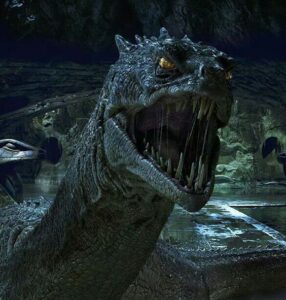
Harry Potter Series by J.K. Rowling: In the “Harry Potter” series, the basilisk plays a significant role in “Harry Potter and the Chamber of Secrets.” Raised by Tom Riddle, an incarnation of Lord Voldemort, the basilisk is used as a tool to unleash terror and petrify students at Hogwarts School of Witchcraft and Wizardry.
Canterbury Tales by Geoffrey Chaucer: In “The Nun’s Priest’s Tale,” a story within “The Canterbury Tales,” Chaucer introduces the character of Chauntecleer, a proud rooster who encounters a fox. While not a basilisk, the tale reflects the medieval fascination with animal symbolism and incorporates elements of mythical creatures.
The Faerie Queene by Edmund Spenser: In Spenser’s epic poem, “The Faerie Queene,” the basilisk is mentioned as a symbol of falsehood and deceit. The Redcrosse Knight faces a basilisk as part of his quest, emphasizing the allegorical nature of the creature in representing moral challenges.
Shakespeare’s “Richard III”: In “Richard III,” Shakespeare uses the term “basilisk” metaphorically to describe the dangerous and threatening nature of the character Richard. The reference reflects the pervasive cultural understanding of the basilisk as a symbol of deadly power.
The Book of Beasts (Bestiaries): Medieval bestiaries, such as “The Book of Beasts,” often featured entries on the basilisk. These illuminated manuscripts described the creature’s legendary birth from a serpent’s egg incubated by a rooster and emphasized its deadly gaze, contributing to the symbolic significance of the basilisk in medieval literature.
“Fantastic Beasts and Where to Find Them” by Newt Scamander (J.K. Rowling): In this supplementary book to the Harry Potter series, Newt Scamander provides information on magical creatures, including the basilisk. The entry details its characteristics, including its lethal gaze, and provides insights into its behavior in magical contexts.
“The Legend of the White Snake” (Chinese folklore): While not explicitly a basilisk, the White Snake in Chinese folklore shares similarities with serpent-like mythical creatures. This legend, adapted in various literary works, explores themes of love, transformation, and the consequences of supernatural abilities.
Visual Arts
“St. George and the Dragon” by Raphael: In this famous Renaissance painting, Raphael depicts the legendary tale of St. George slaying the dragon. While not a basilisk, the dragon in this artwork shares similarities with mythical serpentine creatures, highlighting the artistic representation of fantastical beasts in visual arts.
“The Basilisk” by Gustave Moreau: This 19th-century painting by French symbolist artist Gustave Moreau is a striking representation of the basilisk. Moreau’s imaginative and detailed portrayal captures the creature in a fantastical, dreamlike manner, emphasizing its serpent-like features and mythical aura.
Medieval Illuminated Manuscripts: Basilisks are commonly found in medieval illuminated manuscripts, particularly in bestiaries. These intricate illustrations often accompanied descriptions of the creature’s legendary characteristics, contributing to the visual representation of the basilisk in medieval European art.
“Harry Potter and the Chamber of Secrets” Film: The film adaptation of J.K. Rowling’s “Harry Potter and the Chamber of Secrets” visually brings the basilisk to life. The creature is depicted as a massive serpent with a lethal gaze, and its encounter with Harry Potter in the Chamber is a visually intense and dramatic moment.
Japanese Ukiyo-e Prints: While not specifically featuring the basilisk, Japanese Ukiyo-e prints often depict mythical creatures, including serpents and dragons. These prints, with their intricate details and vibrant colors, contribute to the cultural representation of serpentine and dragon-like beings in Japanese visual arts.
Sculptures and Reliefs on Gothic Cathedrals: Basilisks and other mythical creatures are often carved into the architecture of Gothic cathedrals and churches. These stone sculptures and reliefs serve both decorative and symbolic purposes, reflecting the medieval fascination with fantastical creatures in religious and artistic contexts.
Fantasy Illustrations in Modern Art: Contemporary fantasy artists often incorporate basilisks into their works, creating visually stunning and imaginative representations of the creature. Digital art, illustrations, and concept art for fantasy literature and games showcase the continued influence of the basilisk in contemporary visual arts.
The basilisk’s visual representation in art spans centuries and cultures, reflecting its enduring presence in the human imagination. Artists have used various mediums and styles to bring this mythical creature to life, contributing to its rich iconography in visual arts.
Alchemy
The notion that the ashes of a basilisk retain magical properties aligns with the historical beliefs and practices of alchemy. In alchemical traditions, various substances were believed to contain potent mystical properties, and the pursuit of transmuting base metals into gold and creating the Philosopher’s Stone was central to alchemical endeavors.
The idea that an alchemist could use the ashes of a basilisk to turn silver into gold reflects the alchemical concept of transmutation. Alchemists sought to discover processes or substances that could transform one element into another, with the ultimate goal of achieving the transmutation of base metals into noble metals like gold.
The Philosopher’s Stone, a legendary alchemical substance, was believed to have transformative properties and could grant immortality. The mention of basilisk ashes as an ingredient in the making of the Philosopher’s Stone adds a mythical and mystical aspect to the alchemical narrative.
Overall, this incorporation of the basilisk’s ashes into alchemical legends highlights the symbolic and fantastical nature of alchemy, where mythical creatures and their remains were thought to hold the key to unlocking extraordinary powers and transformations.
Heraldry
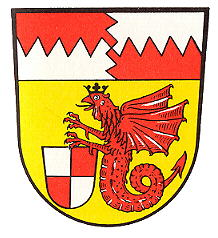
The basilisk has significance in heraldry, where it is often depicted as a mythical creature with a serpent’s body, dragon wings, and a rooster’s head. This heraldic representation aligns with the traditional symbolism of the basilisk, emphasizing its hybrid nature.
In heraldic terms, the basilisk is typically portrayed as a fierce and formidable creature, symbolizing power and protection. Its association with serpents and dragons contributes to its mythical and heraldic significance.
The basilisk may appear as a supporter or charge in a coat of arms, serving as a visual element that represents specific qualities or attributes desired by the individual or entity bearing the heraldic design.
While variations in artistic interpretation exist, the basilisk’s role in heraldry aligns with its historical and cultural symbolism as a creature of myth and legend.
Explanation of the Myth
The Basilisk myth has evolved over centuries, with variations in different cultures contributing to its rich and diverse narrative. General overview of the myth:
Origin and Birth: One common element in the basilisk myth is its unusual and mythical origin. According to certain traditions, the basilisk is believed to be born from a serpent’s egg incubated by a rooster. This hybrid birth, combining features of both a serpent and a rooster, contributes to the creature’s unique characteristics.
Physical Appearance: The basilisk is typically described as a serpent or dragon-like creature. It may have a crest or crown on its head, sometimes resembling the comb of a rooster. The combination of serpent and rooster features emphasizes its mythical and hybrid nature.
Deadly Gaze: One of the most famous attributes of the basilisk is its lethal gaze. Direct eye contact with the basilisk is said to have the power to cause death or turn individuals to stone. This gaze is often portrayed as a potent and immediate threat, adding an element of danger to the myth.
Venomous Qualities: In addition to its gaze, the basilisk is often attributed with venomous qualities. This may include a venomous bite or breath, making the creature a formidable adversary. The idea of a creature with toxic attributes contributes to its fearsome reputation.
Symbolism: The basilisk is often used as a symbol in literature and folklore. It may represent themes of danger, deception, or the triumph of good over evil. Its association with serpents, dragons, and roosters also carries symbolic significance in various cultural contexts.
Heroes and Challenges: In some stories, heroes or protagonists face the basilisk as part of a quest or challenge. Overcoming the basilisk may involve the hero using specific strategies, such as avoiding eye contact, finding magical artifacts, or receiving divine assistance.
Cultural Variations: The basilisk myth has variations across different cultures and historical periods. In European folklore, it is often associated with medieval bestiaries and portrayed as the king of serpents. In other traditions, similar serpent-like creatures with deadly gazes may be categorized under different names.
Literary and Artistic Representations: The basilisk has been a popular subject in literature and art. It appears in works such as “Harry Potter and the Chamber of Secrets,” medieval bestiaries, and paintings by artists like Gustave Moreau. These representations contribute to the ongoing fascination with the mythical creature.
Basilisk myth encompasses a blend of magical, symbolic, and allegorical elements, making it a captivating and enduring part of global folklore and storytelling.
Basilisk FAQ
What is a Basilisk?
A basilisk is a mythical serpent with lethal gaze and venomous qualities, often born from a serpent's egg.
How to Tame a Basilisk?
In fantasy settings, use fertilized eggs, drop them from your inventory, and lure the basilisk to establish control.
How is a Basilisk Born?
According to mythology, a basilisk is born from a serpent's egg incubated by a rooster, emphasizing its hybrid nature.
What is a Basilisk in Harry Potter?
In "Harry Potter," the basilisk is a giant serpent bred by dark magic, guarding the Chamber of Secrets.
